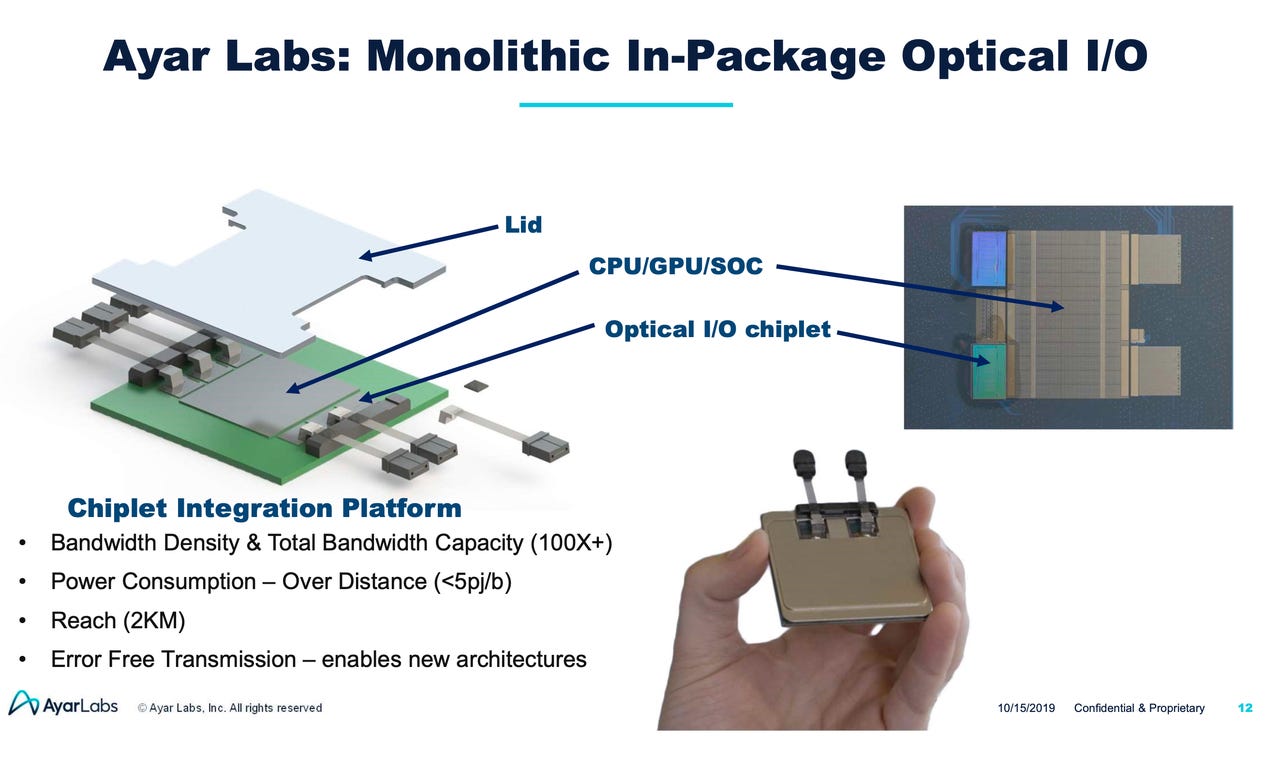Photonics startup Ayar Labs receives $35 million funding to interconnect massively parallel computers


Ayar Labs's first demonstrated device is a 2-terabit-per-second transceiver that sits in a package with an FPGA and converts the bits from the chip into lightwaves to be sent out over a laser.
The age of chips connected via beams of light is upon us, according to Charles Wuischpard, chief executive of Silicon Valley startup Ayar Labs, which has received $35 million in new funding, bringing its total funding to date to roughly $60 million.
Silicon photonics, the long-promised age of chips that do away with copper wires, is coming into focus as massively parallel computer systems require a way to simplify the wiring that joins multiple chips together.
"What if every Xeon CPU in the data center was optically connected versus through copper on the motherboard today?" Wuischpard offered, in an interview with ZDNet via Zoom.
"Nvidia spends a lot of money putting sixteen GPUs in their DGX box," Wuischpard continued. "But in order to expand, and have maybe 256 GPUs addressable in a box, you're going to need to go to an optical interconnect to enable that."
New investors in the Series B round inclue Applied Ventures, the venture capital arm of chip equipment giant Applied Materials; Castor Venures; and Downing Ventures. They join existing investors Intel, Lockheed Martin, Global Foundries, BlueSky Capital, and Playground Global.
Wuischpard knows a thing or two about both optical and massively parallel computing. He ran the supercomputing unit at Intel for several years before coming on board Ayar at the end of 2018. Intel is an investor and a customer, and to some extent, a potential competitor, given that Intel has its own silicon photonics efforts.
Ayar, which was founded by MIT scholars in 2015, has done pioneering work in converting electrical signals to optical signals, to move bits from processors into fiber-optic links. These electro-optic transducers could replace copper wiring in many instances, opening up a world of optically connected chips.
The focus on computing, however, is surprising. For most of its existence, it was thought that Ayar would find its principle market in the need to connect routing and switching chips in data center networking equipment, as speeds of optical links go to 200 gigabits per second and 400 gigabits and beyond.
That opportunity still exists, but Wuischpard has seen the more-immediate opportunity to connect processors that need to scale to thousands of devices per motherboard.
"I think what's happened is that where I saw the opportunity, maybe on the horizon, if you look at the moves made in the industry, plus the architectural statements from all the big guys, everyone sees this as a big opportunity to advance Moore's Law, price, performance, etc."
The company in early 2019 demonstrated a simple 100-gigabit electrical-to-optical converter, and then moved on to developing a chiplet, a part meant to sit next to a processor inside a package. In the demonstration version, the converter is packaged with a Stratix field-programmable-gate array, or FPGA, from Intel. "It's a very complex package, 2.5-D, with fibers attached," noted Wuischpard.
This spring, the company developed a fuller version that can handle over two trillion bits per second, the equivalent of 80 PCIe Gen 5 connections, "all in one little chiplet that's a few millimeters across," said Wuischpard.
Obviously, that ability to condense tons and tons of wire into a single photonic link is a dramatic reduction in space, power and complexity that could make for much denser, more integrated computer systems.
Or, it could lead to much more powerful rack-based server systems. Ayar has been developing an prototype massively parallel computer system with Intel.
"It's an AI application, a brand-new machine, that's a prototype of the future, essentially," Wuischpard
"Think of 5,000 CPUs, each with their own local memory, but with low-latency interconnect, an all-to-all fabric, although not through a switch."
The optical interconnect enables each CPU to see all the memory in the system. "It's unified memory but it's physically disaggregated," Wuischpard explained.
Some stimulations on the machine show on the order of 1,000 times improvement on some workloads versus what can be accomplished in today's machines, said Wuischpard.
The company is currently taping out a version of its latest version TeraPHY chiplet, and is under contract to deliver several thousands of units in 2021, with full production intended to ramp in 2022.
Wuischpard sees the entire world of hybrid computing moving in Ayar's direction.
"Without putting too fine a point on it, in order to really leverage synergy between AMD and Xilinx, you're going to need a very fast interconnect between CPU, GPU, and FPGA combinations, either in package or over distance."
The market for chip M&A tends to reinforce the optical thesis, Wuischpard told ZDNet. Chip maker Marvell Technology Group last week said it would purchase fiber-optic component vendor Inphi for $10 billion in cash and stock at a 41% premium to Inphi's stock price.